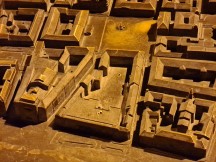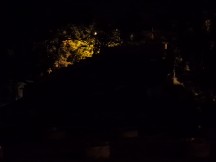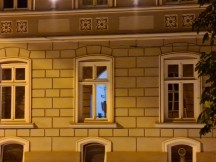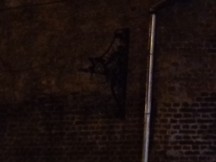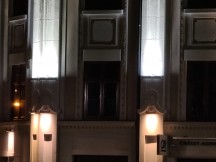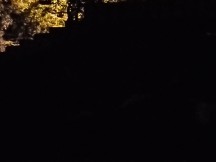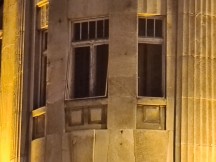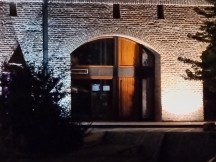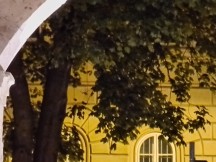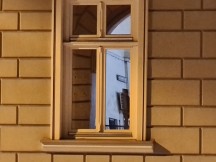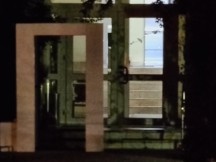Samsung Galaxy S20 Ultra long-term review

Battery life
The S20 Ultra's endurance has been way less impressive than the 5,000 mAh number would lead one to believe it would be. Based on the capacity alone, we were expecting it to easily have managed over two days of usage on one charge, but no, in fact we had to top up the phone every night. Sometimes we'd finish a day with 20+% left, sometimes with much less, but almost never with more, unless we had a day in which we didn't use it almost at all.
We usually give you screen-on time numbers in long-term reviews, to get an idea of what to expect if your use scenario is similar to ours, but in this case, there's a wrinkle, and that's the way that Samsung's software reports battery usage. See, most other pones would tell you how long it's been since the last full charge, and how much screen usage you've had since then. Samsung wanted to be different, and thus it tells you how many hours of screen-on time you had each day. As in, each calendar day. This is obviously discriminatory towards people like this reviewer who are 'night owls' and go to sleep in the early AMs, because now the screen time for a calendar day is partly from before a full charge (while sleeping), partly after.

With this mess in mind, note that we were able to achieve over 5 hours of screen on time on almost all days, with our usage based primarily on Wi-Fi connectivity, with around an hour on 5G, an hour or two of phone calls, Bluetooth always on, around an hour of music streaming, and 30 minutes to an hour of GPS navigation.
Speaking of GPS, for some reason the S20 Ultra seemed to very much enjoy eating up the battery when in navigation mode (we use Waze or Google Maps). And we mean much more (subjectively) than other devices, this sort of reminds us of the situation many years back when GPS chips were highly inefficient. We're not sure what's going on here - maybe the GPS locator chip isn't the best at sipping battery, or something about it having to work alongside the screen being on and an active data connection that creates this feeling, but be prepared to have a charger in the car if you use navigation a lot.
Speaking of charging, the S20 Ultra, despite its price, comes with a measly 25W charger in the box, although Samsung will gladly take more of your money for a 45W brick (that doesn't actually speed up charging all that much). This is... baffling, quite honestly. We found the charging time on the default brick from 0 to 100 to be reasonably decent at just over an hour, but far from record-breaking. And of course, you also have wireless charging for some added flexibility, although that too is anything but the fastest around these days.
Camera
Time to find out if the huge unsightly camera hump was worth it. As in, is there enough quality in there to warrant its size and looks? To make you look past them, even? Well, spoiler alert: yes, but with a couple of huge caveats.
First off, because of the sheer size of the main snapper's sensor, paired with the very bright aperture, it's great at creating some dose of 'natural' bokeh even if you don't employ the dedicated mode for that. Just point and shoot and you're getting more bokeh in auto mode than on any other phone.

This can of course be great if that's what you're after, but here's the thing: the focus plane is quite shallow, probably the smallest for any flagship smartphone, and so if you're shooting a big object that covers most of the frame, some of that is going to be in focus (in the middle), and some of it (to the sides) will not. There's no way around this, you can't just change a setting and mitigate it, because it's a physical hardware thing, not a software setting. Again, this works amazingly for some shots, and very much not amazingly on others. It's a thing to keep in mind, and it, unfortunately, means that you can't trust the S20 Ultra to get every shot right, every time. If you don't like out of focus edges, you will have to think about framing more than with any other smartphone. Or use one of the other cameras on the rear, of course.
Secondly, the S20 Ultra still, after many camera-improving updates, has issues focusing with its main sensor. Both auto-focus and manual focus, it goes focus hunting a lot more than any recent flagship we've seen, and it randomly tends to lose focus, and then go hunting again. The hunting itself rarely takes over 1 or 2 seconds, but the sheer fact that this is a thing and happens this much reminds us of top of the line smartphones from quite a few years ago, or even lower-priced devices from back when focusing wasn't a solved problem on smartphones. In the meantime, it totally has been, until Samsung made it an issue again on the S20 Ultra.
And that's a real shame, because when it does focus, the main camera does churn out some incredibly impressive pictures - if you don't mind the shallow focus plane. And yet - this is not an ideal user experience, and the focus hunting gets especially bad when shooting video. We're not quite sure how Samsung's product planning department decided to let this slide, for a device that's this premium and comes with such a high price tag. The camera quality itself may be outstanding (as you'll see), but the experience of using the S20 Ultra's main camera is trumped by basically all of its competitors.

The camera app is the standard Samsung fare, and it looks very similar to every camera app out there at this point. The one weird thing about it is that things such as Night mode and Live focus (aka Portrait Mode) aren't in the main carousel of shooting modes, you have to go into the More submenu to find them. There is, thankfully, a way in Settings to make these part of the main carousel of options, but why they're not there in the first place is beyond us. The app is easy enough to use otherwise, although in Night mode it has a quirky animation that 'fills up' the shutter button on screen as the timer goes down - that's all fine and dandy, except the bubble always gets filled up before the countdown actually expires. This threw us off the first few times, then we just learned to live with it, but more attention to such details wouldn't have hurt.
As mentioned above, the S20 Ultra's main cam produces stunning images in broad daylight. Note that as usual in long-term reviews we're going with Auto-mode here, which spits out pixel-binned 12 MP images. The quality is definitely great, with practically no noise, and very good dynamic range. It's all what you'd expect from such a top of the line device, and while the colors do 'pop' more than they do in real life, they don't go overboard, at least for our taste. If you dig natural accurate looks, though, you're probably not looking into a Samsung smartphone anyway.






























Daytime samples from the main camera
The ultrawide is very good too, with similarly punchy colors and good dynamic range, if lacking in detail somewhat. Then again, that's pretty much the case with all ultrawides, with some notable exceptions on the Huawei and Apple sides of the fence. It's also properly wide, unlike some competitors. Sadly though it doesn't have autofocus which for a top tier handset is a very weird oversight. Edge distortion is corrected very well.
























Daytime samples from the ultrawide
The S20 Ultra's periscope zoom camera does about 4x optical zoom, but confusingly the 'zoom' setting in the camera app takes you to 5x, which is a hybrid zoom. With this in mind, we decided to do things differently than usual, and not go with the default settings here. Instead, we manually chose 4x and also tested 10x hybrid zoom to see if those shots are usable. Spoiler alert: they are, very much so, especially for social media use.
The 4x shots come with excellent detail, no noise, nice colors, high contrast, and pleasantly wide dynamic range. The 10x images are understandably less impressive. Sharpness and detail levels are still decent, though.
We shot a few of 100x "Space Zoom" photos just to show that there definitely wasn't any need for this bombastic marketing. Maybe if you really really have to use them, they'll do just fine, but even on the phone's screen they just plain look bad. It's great to see that we have a slider going up to a crazy 100x on a phone, perhaps, yay innovation and all that. But this is just not something you will use more than once or twice a month, or less.
The huge sensor of the main cam did make us expect amazing night time shots, and it did not disappoint. These are excellent images, with good levels of detail and noise that is handled very well. Color rendition is on point, with some 'pop' even - a rare feat for nighttime shots in general. Dynamic range is good too, and you can improve it with Night mode of course.


















Nighttime samples, main camera
If you choose to go this route, the highlights will be reigned in, the shadows lit up, while colors are saturated even more. Expect practically no noise in this mode. It does take a while to capture Night mode pictures, and the Auto mode ones at night are so good already that you may find yourself skipping on Night mode quite often.















Night mode samples, main camera
The ultrawide at night is obviously not in the same league as the main shooter, but it does hold its own, at least compared to some other efforts we've seen. It manages to show decent amounts of detail, especially where you have some light sources around, and the dynamic range is also decent for an ultrawide. That said, when there's practically no light around your shot, things get very dark very fast.
Night mode lifts the shadows here too, and amps up the dynamic range as a consequence, while the highlights are retained somewhat better and the colors boosted. You also get less noise but at the cost of some added softness.
Zoom at night produces pleasing images at 4x, with good detail levels, color rendition, and dynamic range.
When you add Night mode to 4x shots, they're pretty much universally made better, at the cost of each snap taking a while. You also lose some sharpness, but gain punchier colors, boosted shadows, and better highlights - yeah, this is a theme with Samsung's Night mode on all cameras on offer here.
10x shots at night are, most of the time, practically unusable, unless you're really lucky, so we wouldn't go that far on the magnification slider unless our life depended on it. These are the best shots we captured with this setting, but countless others had to be discarded.
Selfies during the day are generally very good, with great levels of detail, nice and punchy colors, and excellent dynamic range. Live focus (aka Portrait mode in Samsung parlance) is good most of the time, even if sometimes it does go crazy with misinterpreting what's going on in the bordering regions of subject separation.






Daytime selfies, Live focus (aka Portrait mode) off/on
At night the selfie quality drops significantly, which isn't unexpected at all - this is pretty much par for the course for all selfie cams, especially when you're not using a 'screen flash' feature. We weren't here, just to show you how bad things get when there's barely any light around, and how passable the selfies get when you are at least close to a light source.

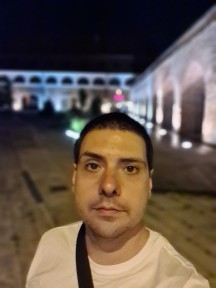


Nighttime selfies, Live focus (aka Portrait mode) off/on
Overall, the Galaxy S20 Ultra has a very capable camera system, both front and back, which is not perfect because of a few issues. The ultrawide isn't the best out there, and the main camera, while very interesting as a technological accomplishment in its own right, unfortunately just doesn't provide a perfect user experience because of its focusing issues - even if the shots it produces are very good, perhaps among the best out there at the moment.
Reader comments
- ANDROIDIAN
- 07 Jun 2023
- Iby
👁 2nd dat ✔
- Mr iiq
- 09 Jan 2023
- uZa
Samsung Super class is Always good quality
- Anonymous
- 06 Oct 2022
- sr2
2.8























































































